Intercompany Accounting for Multiple Companies with a Single Set of Books
By Jag - August 09, 2012
Depending upon your company and subsidiary business needs, General Ledger offers a number of solutions to automatically account for intercompany transactions within a single set of books.
General Ledger can automatically balance intercompany journals based on accounts you define in the Intercompany Accounts window. General Ledger creates balancing journal lines when you post, using the appropriate intercompany accounts you specify for the source, category, and balancing segment.
For General Ledger to automatically balance intercompany journals, you must enable the Balance Intercompany Journals option in the Set of Books window. (Optional) You can create an intercompany segment in your chart of accounts structure. The intercompany segment shares the same value set as the balancing segment and is used in the account code combination General Ledger creates to balance intercompany journals.
The intercompany balancing segment provides more detail for reporting and reconciliation.
1. Standard Intercompany Balancing
General Ledger can create generic balancing lines against the intercompany accounts that you have defined for specific sources and categories. This method does not track payable and receivable balances for specific trading subsidiaries.
Assume you define the intercompany accounts shown in the table below for a specific source and category:
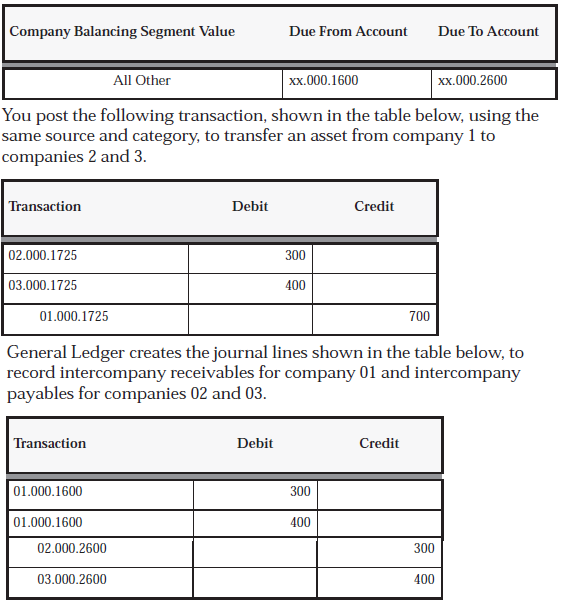
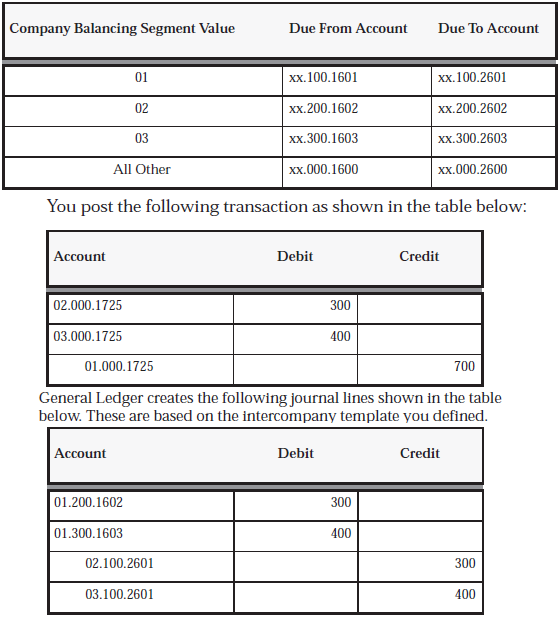
Instead of using different natural accounts to track intercompany balances, you can use an intercompany segment in your chart of accounts to record the same detail as the enhanced intercompany balancing described above.
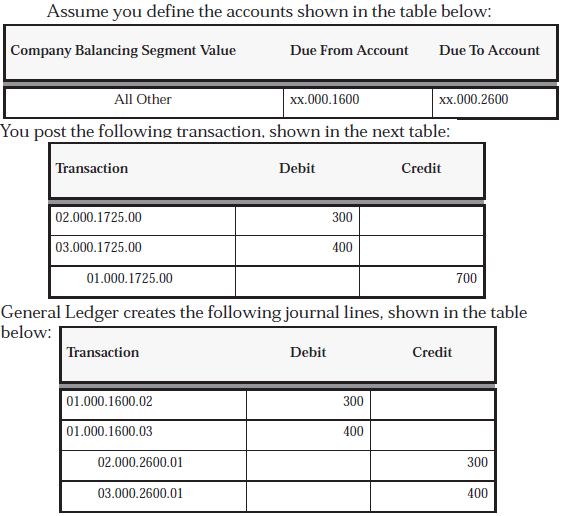
The following example shows how General Ledger treats intercompany transactions when many companies are trading with many companies. Assume you create the accounts listed in the following table:
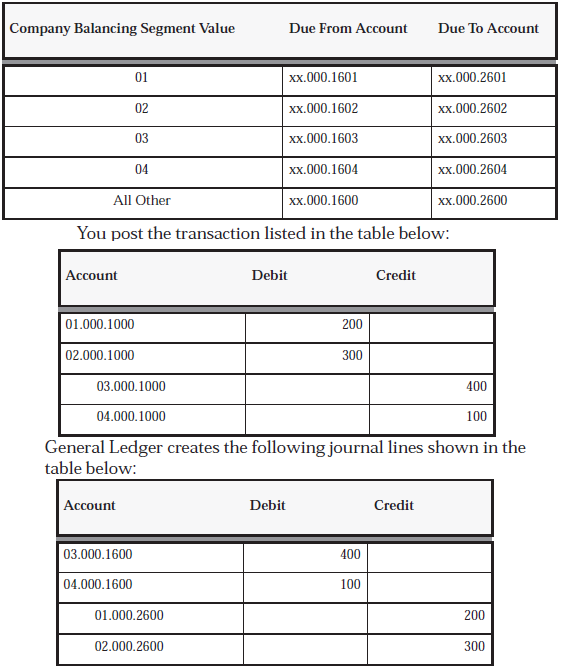
models below.
5. Clearing Companies
Your organization can designate one company to act as an operational unit for all subsidiary companies in the organization for certain kinds of transactions. Intercompany Balancing in General Ledger supports this kind of operational decision.
For example, company 01 among your subsidiary companies may provide the accounts payable function for your entire organization. All accounts payable transactions clear through company 01. When you create a clearing company like this, you can:
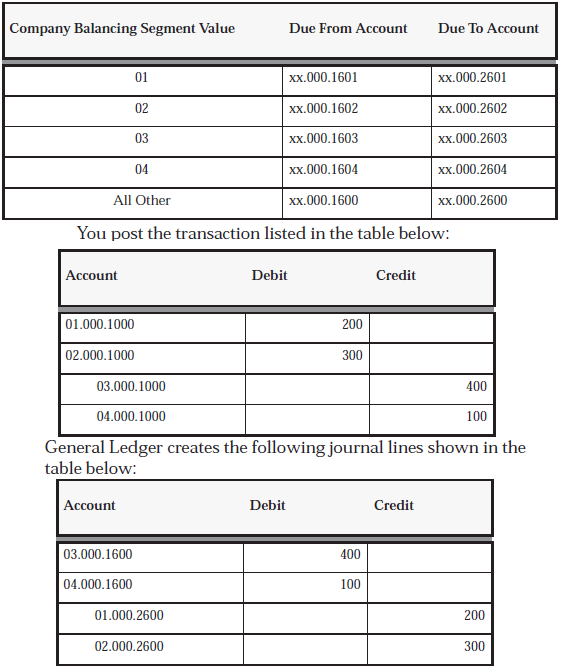
6. Using the intercompany segment in the clearing company model:
Assume you define the accounts, listed in the table below, in the detail region of the Intercompany Accounts window. You choose company 06 as the clearing company.

General Ledger can automatically balance intercompany journals based on accounts you define in the Intercompany Accounts window. General Ledger creates balancing journal lines when you post, using the appropriate intercompany accounts you specify for the source, category, and balancing segment.
For General Ledger to automatically balance intercompany journals, you must enable the Balance Intercompany Journals option in the Set of Books window. (Optional) You can create an intercompany segment in your chart of accounts structure. The intercompany segment shares the same value set as the balancing segment and is used in the account code combination General Ledger creates to balance intercompany journals.
The intercompany balancing segment provides more detail for reporting and reconciliation.
1. Standard Intercompany Balancing
General Ledger can create generic balancing lines against the intercompany accounts that you have defined for specific sources and categories. This method does not track payable and receivable balances for specific trading subsidiaries.
Assume you define the intercompany accounts shown in the table below for a specific source and category:
2. Enhanced Intercompany Balancing
You can define separate intercompany account templates to record more detail for your intercompany journals and track intercompany balances by trading subsidiary.
In the detail region below, you define the accounts shown in the following table:
You can define separate intercompany account templates to record more detail for your intercompany journals and track intercompany balances by trading subsidiary.
In the detail region below, you define the accounts shown in the following table:

Note: The balancing segment value you define in the template behaves dynamically in the resulting balancing lines. It will
change based on the balancing segment value of the trading partner. The other segments in the template remain unchanged in the resulting balancing lines. These account templates are used when a transaction is balancing against a specific company. For example, if a transaction is balancing against company 01, then the accounts defined for Company 01 in the Due From and Due To Account fields are used.
3. Intercompany Segment Balancingchange based on the balancing segment value of the trading partner. The other segments in the template remain unchanged in the resulting balancing lines. These account templates are used when a transaction is balancing against a specific company. For example, if a transaction is balancing against company 01, then the accounts defined for Company 01 in the Due From and Due To Account fields are used.
Instead of using different natural accounts to track intercompany balances, you can use an intercompany segment in your chart of accounts to record the same detail as the enhanced intercompany balancing described above.

This method records information similar to that of the enhanced balancing method. The results of the above transactions show that company 01 has intercompany receivables of 700: 300 from company 02 and 400 from company 03. We can also tell that company 02 has an intercompany payable to company 01 of 300 and company 03 has an intercompany payable to company 01 of 400.
4. Enhanced Intercompany Balancing – Intercompany Transactions with many companies to many companiesThe following example shows how General Ledger treats intercompany transactions when many companies are trading with many companies. Assume you create the accounts listed in the following table:

The result tells us that company 01 has intercompany receivables of 200, company 02 has intercompany receivables of 300, company 03 has intercompany payables of 400 and company 04 has intercompany payables of 100. This result does not track from which companies the receivables are due or to which companies the payables are due.
To track receivable and payable relationships among many companies trading with one another, see the clearing companymodels below.
5. Clearing Companies
Your organization can designate one company to act as an operational unit for all subsidiary companies in the organization for certain kinds of transactions. Intercompany Balancing in General Ledger supports this kind of operational decision.
For example, company 01 among your subsidiary companies may provide the accounts payable function for your entire organization. All accounts payable transactions clear through company 01. When you create a clearing company like this, you can:
- Consolidate the accounts payable activities for the entire company
- Automatically balance multi company intercompany transactions
- Track the amounts each individual subsidiary owes to each other subsidiary

The result tells us that company 04 has intercompany receivables of 700: 300 from company 02 and 400 from company 03. It also tells us that company 02 has an intercompany payable to company 04 of 300 and company 03 has an intercompany payable to company 04 of 400. Company 01 has intercompany receivables of 700 from company 04. Company 04 has an intercompany payable to company 01 of 700. Companies 01 through 03 balance against the clearing company, 04.
If you create an intercompany journal and you do not specify the clearing company in the Enter Journals window, the transaction posts against the default balancing segment value you specify in the default clearing company field. 6. Using the intercompany segment in the clearing company model:
Assume you define the accounts, listed in the table below, in the detail region of the Intercompany Accounts window. You choose company 06 as the clearing company.

If you create an intercompany journal involving many companies and you do not specify the clearing company in the Enter Journals > More Criteria window, the transaction posts against the default company you specifed in the Default Clearing Company field. General Ledger automatically uses the intercompany segment in the account code combination to track balances by trading subsidiary.
You can override the default clearing company in the intercompany account definition by specifying a clearing company in the Enter Journals window.
You can override the default clearing company in the intercompany account definition by specifying a clearing company in the Enter Journals window.

0 comments